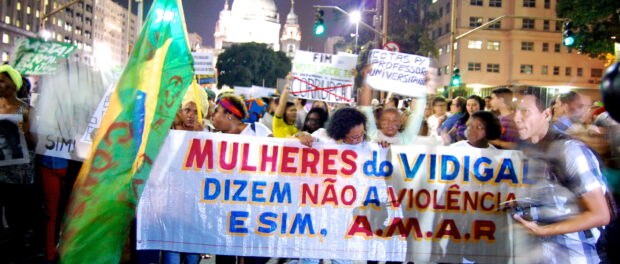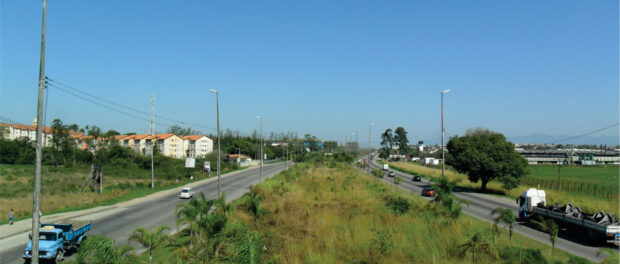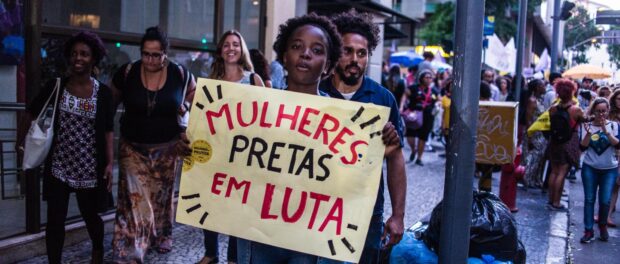
This is the fourth and final article in a four-part series highlighting research that demonstrates the unequal geographic distribution of violence against women in the context of pre-Olympic evictions in the city of Rio de Janeiro.
Non-belonging, that is, the severing of bonds of attachment between a population and its territory, is an instrument of control that has historically been used as a tactic to advance processes of eviction or dispossession. Since the colonization of Brazil, the occupation, demarcation, and affirmation of physical and geographical control over space have formed the foundation of a set of deliberately unequal social and spatial relations. This dynamic of territorial fragmentation, the obstruction of access, and the expansion of settlements is characteristic of colonial-style occupation and is echoed in the contemporary production of urban space.
As such, beyond clearly signaling the advance of real estate speculation and the market-based logic underlying the production of urban space, the Minha Casa Minha Vida (MCMV) federal public housing program—an heir to colonial urbanism—can also be interpreted as a tool of necropolitics. Necropolitics can be defined as the power to take away life held by the government, to the extent that individuals become superfluous and the workforce expendable for the reproduction of capital. Taking away life doesn’t only mean the act of killing, but also letting people die in neglecting to provide the infrastructure that sustains life and exposing people to the risk of death, such as through exposure to violence and insecurity. In this context, the dimension of race is fundamental to understanding how this mechanism operates: in deciding who should live and who should die, the government defines internal enemies based on invariably racist criteria.
This is evident in the logic of MCMV in terms of the locations of housing developments, forgoing any possibility of promoting the right to the city. Through a municipal decree, the City of Rio de Janeiro defined Planning Area 5 (AP5), located in the far west of the city (two hours by transit from the city center), as a priority for the implementation of MCMV developments. Of MCMV’s 96 housing complexes, 49% were built in Planning Area 5. Of these, 53% are intended for families within the income bracket eligible for Social Interest Housing. Discussions on institutional racism—state racism—challenge interpretations of racial inequalities as the result of individual actions, demonstrating that there are mechanisms of structural discrimination that operate through public policies. What is suggested here is the possibility of similar parameters in force, a mechanism of gender discrimination that is a structural part of the hegemonic power and serves to maintain the status quo: institutional sexism.
The City of Rio de Janeiro, through MCMV, implemented 37 Social Interest Housing developments. Of these, 73% were constructed in areas with high rates of violence against women in absolute numbers and that are among the Integrated Public Security Districts (CISPs) with the highest rates of violence per 10,000 women (according to data from the year 2010). Of the 30,211 Social Interest Housing units built since 2009, 77% are located in the 32nd CISP, composed of the neighborhoods of Anil, City of God, Curicica, Jardim Azul, Jacarepaguá, and Taquara; in the 35th CISP, composed of the neighborhoods of Campo Grande, Cosmos, Inhoaíba, Santíssimo, and Senador Vasconcelos; and in the 36th CISP, composed of the neighborhoods of Paciência and Santa Cruz, as shown in Table 1.
Table 1: Minha Casa Minha Vida housing complexes built in each Integrated Public Security District (CISP). Table created by the author.
| CISP | No. of Developments | No. of Housing Units | Percentage | |
| 6 | 1 | 990 | 3.28% | |
| 17 | 1 | 496 | 1.64% | |
| 21 | 1 | 200 | 0.66% | |
| 31 | 1 | 240 | 0.79% | |
| 32 | 4 | 4,620 | 15.29% | |
| 34 | 1 | 1,182 | 3.92% | |
| 35 | 10 | 3,967 | 13.13% | |
| 36 | 13 | 14,216 | 47.06% | |
| 39 | 2 | 1,820 | 6.02% | |
| 40 | 1 | 2,240 | 7.42% | |
| 44 | 2 | 240 | 0.79% | |
| TOTAL | 37 | 30,211 | 100% |
Of the instances of rape that took place in 2016 in Rio de Janeiro’s West Zone (where a woman was raped every 13 hours), 48% took place in the areas where the most MCMV housing complexes were built—namely, in the 32nd, 35th, and 36th CISPs.
The process of urban segregation and the peripheralization of housing affects women more acutely—not only because of the lack of basic urban infrastructure and essential services, like daycare centers, schools, hospitals, and transportation, but also because of domestic and urban violence. Distance relative to former place of residence is another important factor because displacement to excessively distant locations can break ties of solidarity and mutual support, which, for women—who are responsible for reproductive labor and caring for dependents—are essential in order to maintain work relations and individual autonomy.
The notion of the “right to the city” is central to the contemporary critique of inequality of access to urban infrastructure, but as a general rule, it is a criticism irrespective of gender, race, or class. In this sense, what is the paradigm for realizing the “right to the city” for women?

Obtaining housing is indispensable to the exercise of citizenship. The effectiveness of housing policy, however, cannot be reduced to the construction of four walls and a roof. It requires a broader view of reality, including issues such as education, health, work, and income generation.
In 2016, approximately three women were raped each day, a woman was killed every three days, and nine women were physically abused every five hours in the city of Rio de Janeiro. It is not a question of denying the importance of large-scale housing production for the low-income population and the potential progress that MCMV represents given the resources invested in Social Interest Housing, but rather a question of highlighting another factor that solidifies criticisms concerning the logic of the program’s locations, specifically in Rio de Janeiro.
Finally, it is important to highlight that in the West Zone—the same region with alarming rates of violence against women—strong feminist collectives exist and resist. In the struggle against evictions, new challenges and threats demand political organization and the strengthening of strategies and discourse. “Women,” as a collective subject, have established a new political ethic based on care and daily relationships, solidifying a strategy to combat the constant attempts to strip away rights. Thus, constructing new meanings and building the city every day in communities facing eviction like Barrinha, Araçatiba, Rio das Pedras, Vargem Grande, and in Vila Autódromo, women keep fighting.
Complete Series: Violence Against Women in the Context of Rio’s Pre-Olympic Evictions
Part 1: Introduction
Part 2: Violence as a Policy of Control
Part 3: Domestic Violence and Femicide
Part 4: Institutional Sexism in a Patriarchal City


